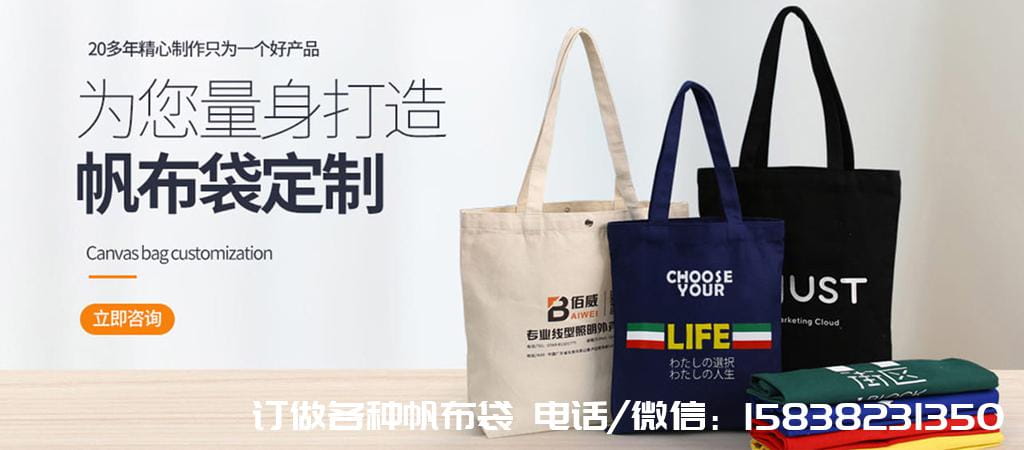原标题:棉布手提袋真的那么环保吗?真相出乎意料

添加微信好友, 获取更多信息
复制微信号
今年流行背什么包?如果你稍微留意一下,你会发现周围的很多女生都背着棉布手提袋,看上去轻便又环保。但是棉布袋真的对环境无害吗?事实可能会让你大吃一惊!

Cotton bags have become a means for brands, retailers and supermarkets to telegraph a planet-friendly mindset – or, at least, to show that the companies are aware of the overuse of plastic in packaging.
棉布袋已经成为品牌、零售店和超市传达环保理念的一种手段,至少是要表明企业对于过度使用塑料包装的态度。
"There’s a trend in New York right now where people are wearing merch: carrying totes from local delis, hardware stores or their favourite steakhouse,” says designer Rachel Comey.
设计师瑞秋·科米说:“纽约当下掀起了一波背环保购物袋的风气,包括本地熟食店、五金店和最喜爱的牛排餐厅的手提袋。”
So far, so Earth-friendly? Not exactly. It turns out the wholehearted embrace of cotton totes may actually have created a new problem.
到现在为止看起来是不是很环保?未必。事实证明,棉布手提袋潮流可能引发了新的问题。
An organic cotton tote needs to be used 20,000 times to offset its overall impact of production, according to a 2018 study by the Ministry of Environment and Food of Denmark. That equates to daily use for 54 years – for just one bag.
丹麦环境和食品部2018年的一项研究发现,一个有机棉手提袋需要被使用2万次才能抵消其生产过程中对环境的总体影响。也就是说,必须每日帆布袋定做电话/微信:15838231350坚持使用一个手提袋长达54年。
Cotton is water-intensive, and figuring out how to dispose of a tote in an environmentally low-impact way is not nearly as simple as people think, according to Travis Wagner, an environmental science professor at the University of Maine.
缅因大学环境科学系教授特拉维斯·瓦格纳指出,棉布的生产需要耗费大量水资源,用尽可能环保的方式处理废弃棉布袋也远远没有人们想的那么简单。
You can’t, for example, just put a tote in a compost bin, and only 15 percent of the 30 million tons of cotton produced every year actually makes its way to textile depositories. Even when a tote does make it to a treatment plant, most dyes used to print logos onto them are PVC-based and thus not recyclable; they’re “extremely difficult to break down chemically,” said Christopher Stanev, the co-founder of Evrnu, a Seattle-based textile recycling firm. Printed patterns have to be cut out of the cloth; Mr. Stanev estimates 10 to 15 percent of the cotton Evrnu receives is wasted this way.
比如说,你不能直接将棉布袋放进堆肥箱里。每年生产出的3000万吨棉布只有15%会被制成纺织品。即使一个棉布袋进入了垃圾处理厂,多数用于印刷标识的染料都是聚氯乙烯材质的,无法被回收利用。位于西雅图的纺织品回收公司Evrnu的联合创始人克里斯多夫·史坦涅夫说,这些染料“极难被化学分解”。棉布上印有图案的部分必须被裁掉,据史坦涅夫估计,Evrnu公司收到的棉制品约有10%到15%是这样被浪费掉的。

That’s not to say cotton is worse than plastic, or that the two should even be compared. While cotton can use pesticides and has dried up rivers from water consumption, lightweight plastic bags use greenhouse gas-emitting fossil fuels, are not biodegrade and clog up the oceans.
这并不是说棉布袋比塑料袋更糟,或者二者可以相提并论。尽管生产棉花需要使用杀虫剂,还会耗费大量的水,但是制作轻薄塑料袋的化石燃料会产生温室气体,不能被生物降解,还会在海洋中堆积成山。
Buffy Reid, of the knitwear label &Daughter, halted production of her cotton bags in April this year. Aesop is converting the composition of its shopping bags to a 60-40 blend of recycled and organic cotton. “It will cost us 15 percent more,” says Suzanne Santos, the chief customer officer of Aesop, but “it reduces water by 70 percent to 80 percent”.
针织服装品牌&Daughter的巴菲·里德今年四月已经停止生产棉布袋。护肤品牌伊索开始转向生产60%回收棉和40%有机棉混纺的购物袋。伊索的首席客户官苏珊娜·桑托斯说:“这将让我们的成本增加15%,但是能使耗水量降低70%到80%。”
Some brands are turning to other textile solutions. Designer Ally Capellino recently swapped cotton for hemp, while Hindmarch introduced a new version of her original tote, this time made from recycled water bottles; Nordstrom also uses similar bags in its stores.
一些品牌转而使用其他针织面料。设计师箱包品牌Ally Capellino最近用麻取代了棉,而希德玛芝品牌推出了一款用回收水瓶制作的新版原创手袋。诺德斯特龙百货店也在门店使用了类似材质的购物袋。
In the end, the simplest solution may be the most obvious. “Not every product needs a bag,” Comey says.
说到底,最简单的解决方案或许也是最显而易见的。正如科米所说:“不是每个产品都需要袋子。”
英文来源:纽约时报
翻译&编辑:丹妮

